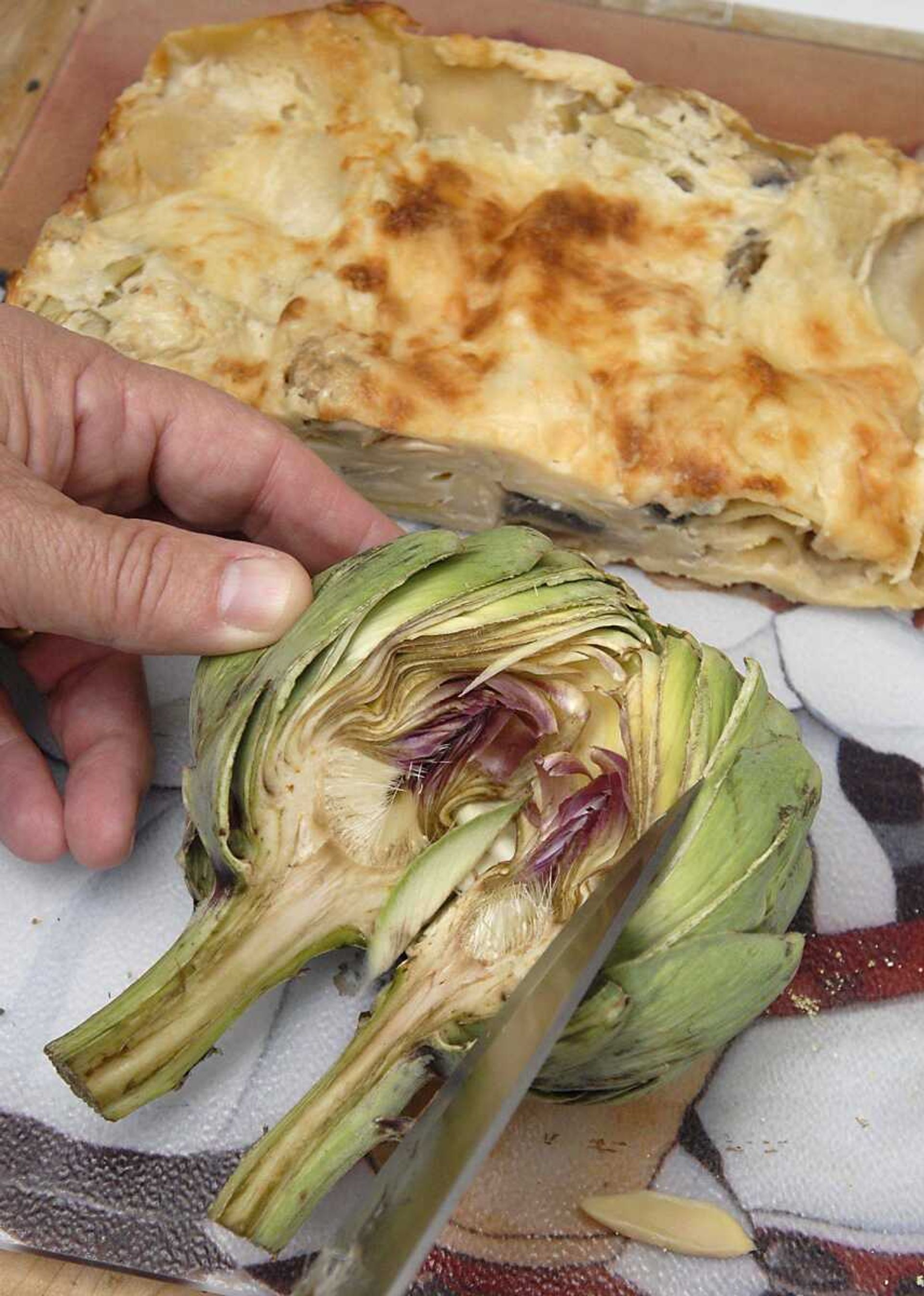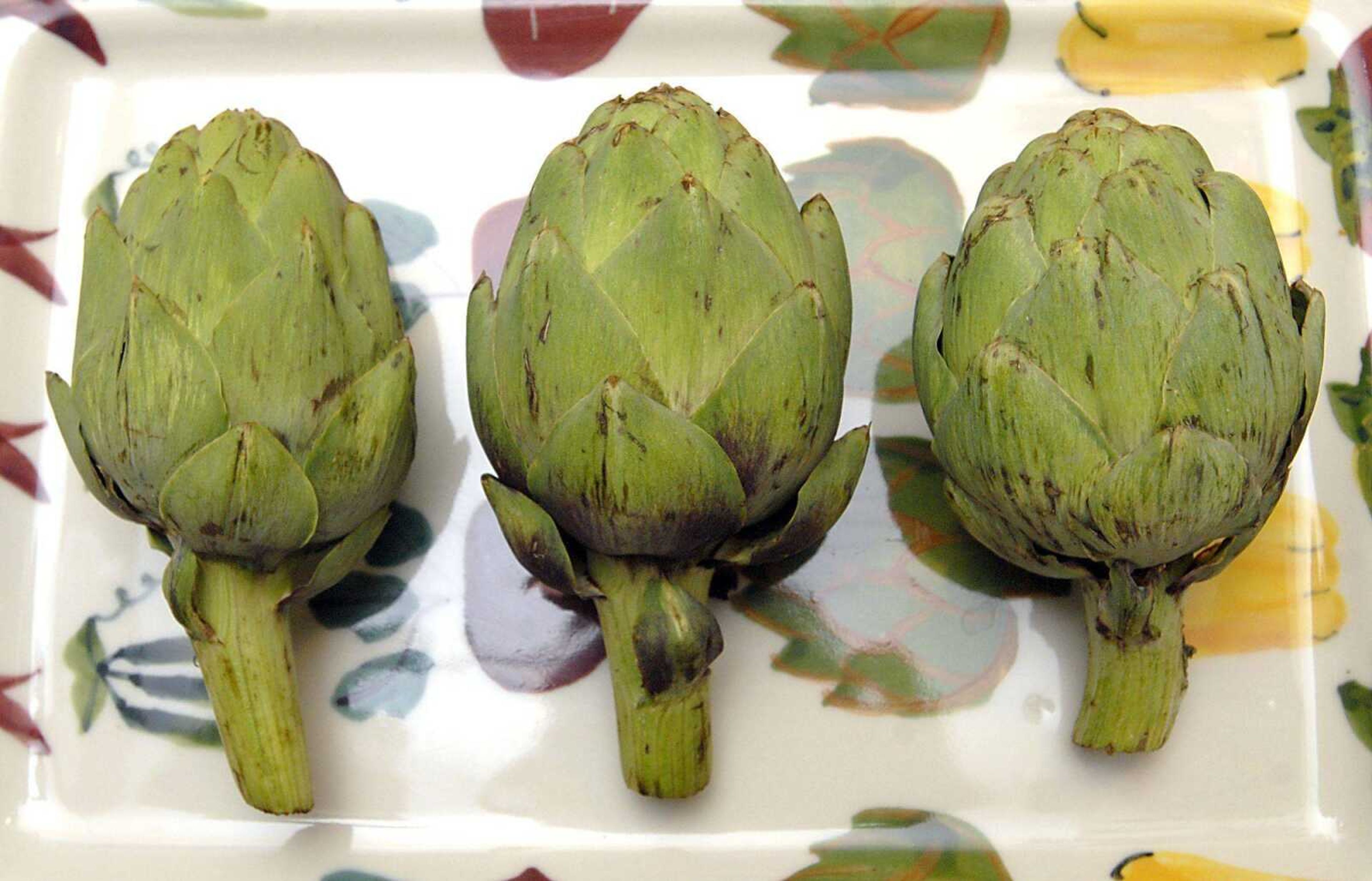A Harte Appetitie: Artichokes worth the effort
Front teeth and patience. As the Oxford Companion to Food remarks, that's what an artichoke requires. The least user-friendly vegetable, it puts the would-be diner through a veritable obstacle course. Not only does it have thorns (it is, after all, a thistle), it looks like a suit of armor. ...
Front teeth and patience. As the Oxford Companion to Food remarks, that's what an artichoke requires. The least user-friendly vegetable, it puts the would-be diner through a veritable obstacle course.
Not only does it have thorns (it is, after all, a thistle), it looks like a suit of armor. The leaves, only the bottoms of which are edible, must be taken off one at a time and scraped between your teeth to get at the meat. When they have all been removed you reach the fuzzy center of the plant, called the choke. If you tried to eat it you'd know how apt the name is. Completely inedible, it must be carefully cut out with a knife to reveal the prized heart or bottom.
Yet despite all the hurdles posed by artichokes, some people refuse to be intimidated. A recent visit to Castroville, Calif., the self-proclaimed "Artichoke Center of the World," showed me why. There, in this otherwise unpretentious town situated along the Pacific Coast Highway, nearly all of the U.S. crop is grown. No wonder, then, that in local establishments like the landmark Giant Artichoke restaurant, with its mammoth 16-foot-tall plastic artichoke out front, you can get the vegetable prepared in just about every conceivable, and in some cases inconceivable, way -- all delicious. There are fried artichokes and sauted artichokes and grilled artichokes and pickled artichokes and even artichoke cake. During the town's annual artichoke festival, where Marilyn Monroe once reigned as Artichoke Queen, they serve artichoke ice cream.
But artichoke worship hardly began in modern-day California. It can be traced back to ancient times. One of the oldest foods known to humankind, the artichoke figures in Greek mythology, and though Pliny the Elder called it "one of the earth's monstrosities," it was nonetheless the most expensive vegetable in the Roman market.
After the fall of Rome the popularity of artichokes likewise fell. Then in the 16th century Catherine de Medici introduced them to France, bringing them with her from her native Italy upon her marriage to King Henry II. They came into vogue once again, some say because of their alleged aphrodisiac properties. By the 18th century they were being cultivated throughout Europe and soon made their way to this country, the French bringing them to Louisiana and the Spanish to California.
Today, thanks to the folks in Castroville, they're available everywhere and year-round, making it easy for connoisseurs to eat their hearts out.
Artichoke Lasagna

This dish, adapted from a recipe in Bon App¿tit Magazine, is often enjoyed in California artichoke country. For convenience we've opted for frozen chokes here.
6 1/2 tablespoons butter, divided
1 pound mushrooms, sliced
3 garlic cloves, minced
1 pound frozen artichoke hearts, thawed
1 cup dry vermouth
4 1/2 tablespoons flour
4 1/2 cups milk
2 1/2 cups grated Parmesan cheese
Ground nutmeg
9 ounces no-boil lasagna noodles
1 pound thinly sliced mozzarella cheese
Saut¿ mushrooms and garlic in two tablespoons butter over medium-high heat until mushrooms release juices and begin to brown. Coarsely chop artichokes and add to pan along with vermouth. Cook, stirring occasionally, until liquid is absorbed. Melt remaining 4 1/2 tablespoons butter over medium-high heat, add flour, and stir one minute. Gradually whisk in milk. Reduce heat to medium and simmer until sauce thickens, stirring occasionally. Stir in 1 1/2 cups Parmesan and season with salt, pepper and nutmeg. Spread 2/3 cup sauce over bottom of a 9-by-13-inch glass baking dish. Cover with a layer of noodles. Spread 1/4 of artichoke mixture over noodles and cover with another 2/3 cup sauce. Arrange 1/4 of mozzarella over all, sprinkle with 3 tablespoons Parmesan and top with another layer of noodles. Repeat layering until all ingredients are used, finishing with remaining sauce and cheese. Cover with foil and bake at 350 degrees for 1 hour. Remove foil, increase temperature to 450 degrees and bake until golden on top.
Tom Harte's book, "Stirring Words," is available at local bookstores. A Harte Appetite airs Fridays 8:49 a.m. on KRCU, 90.9 FM. Contact Tom at semissourian.com or at the Southeast Missourian, P.O. Box 699, Cape Girardeau, Mo., 63702-0699.
Connect with the Southeast Missourian Newsroom:
For corrections to this story or other insights for the editor, click here. To submit a letter to the editor, click here. To learn about the Southeast Missourian’s AI Policy, click here.










